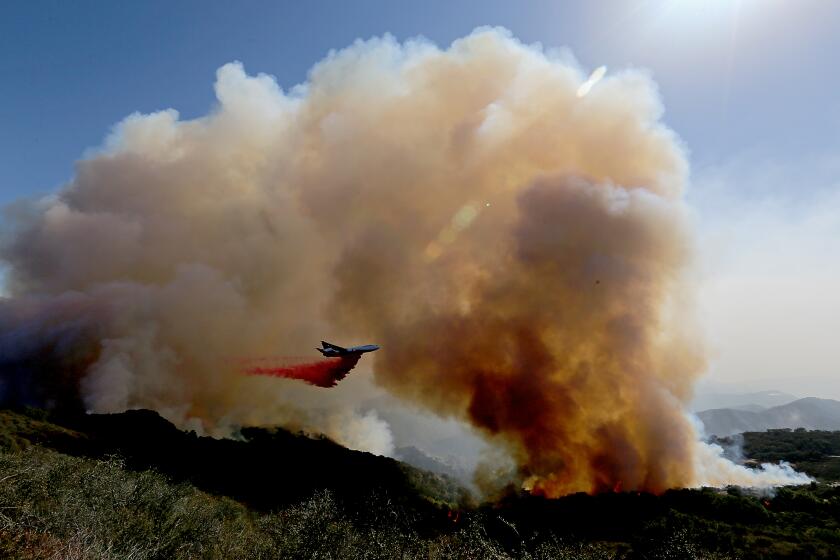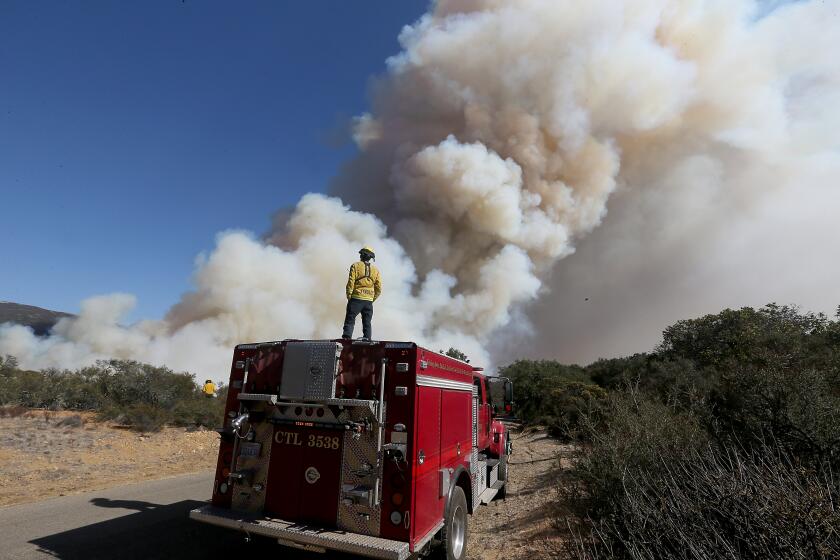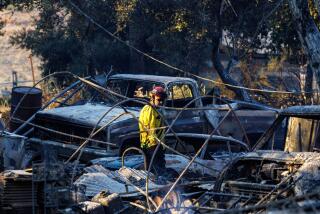A rare plant and a president’s ranch are threatened as Alisal fire grows

The Alisal fire in Santa Barbara County swelled for the third day as flames closed in on homes, threatened Ronald Reagan’s old ranch and kept the 101 Freeway shut down.
The blaze — the first major wildfire in Southern California this season — arrived amid howling sundowner winds that pushed it over ridges, through canyons and down toward the coast. Drought-parched grasses and chaparral ignited with ease, and fire officials said some airborne embers were landing more than a mile away.
By Wednesday evening, the fire had grown to 15,442 acres and was 5% contained. Santa Barbara County officials declared a local emergency, and Gov. Gavin Newsom secured federal assistance for the blaze.
Fueled by bone-dry vegetation, the Alisal fire has burned 13,000 acres and is 5% contained.
The area where the fire is burning, which spans from from El Capitan State Beach to Gaviota along the coast and inland toward Solvang, is home to several sprawling ranch properties, many of which have been in the same families for generations.
There are other items of concern tucked among the quiet hillside homesteads, including the presidential ranch, a population of rare plants and a controversial oil processing facility. With more erratic winds expected soon, officials said the worst could be yet to come.
“We’ll be very, very busy out there,” Santa Barbara County Fire Chief Mark Hartwig said during a news conference Wednesday. “We expect that for weeks, if not months, you will see fire crews out there putting out hot spots on this fire.”
Among firefighters’ top priorities was Rancho del Cielo, the 688-acre ranch known as the “Western White House,” where former President Reagan and his wife, Nancy, played host to several world leaders.
The property’s current manager, Flemming Bertelsen, said the fire had come within a quarter-mile of the ranch but that so far it had “dodged a bullet.”
Fueled by 40-mph sundowner winds, the Alisal fire defied containment in Santa Barbara County. Strengthening winds promised even more challenges.
Bertelsen, a former wildland firefighter, said he and four other workers were focused on fuel reduction and structure defense, including clearing away dried leaves and twigs that blew during strong winds. It was far too soon to call the battle won, he said.
Also of concern is an ExxonMobil processing facility in nearby Las Flores Canyon, which has been out of commission since the 2015 Refugio oil spill. Infrared mapping appeared to show the fire burning into the canyon, but Exxon spokeswoman Julie King said no damage has been reported.
The facility remains in a “safe, preserved state,” and officials are watching the fire closely, she said.
Exxon has been exploring the possibility of revitalizing the facility and trucking the oil along the Central Coast, prompting controversy locally.
The fire this week also surrounded Tajiguas Landfill, which Santa Barbara County officials noted is far more than a dump: In June, the county completed a two-year, $150-million project that transformed portions of the facility into a resource recovery center, replete with an anaerobic digester that converts methane from organic material into energy.
On Tuesday, areas of the landfill smoldered and burned after a flare-up ignited in the biofilter’s uncovered concrete structure, which is filled with wood chips.
Strong winds are expected to hit swaths of California on Thursday and Friday, prompting warnings of fire and potential power shutoffs.
Meanwhile, some environmental groups are watching the fire closely as it burns into chaparral ecosystems and around a rare plant species known as Refugio manzanita. The shrubs are endemic to Santa Barbara County and found only between 1,000- and 3,200-foot elevations in the Santa Ynez Mountains, according to Los Padres ForestWatch.
After sparking Monday afternoon, the Alisal fire grew hundreds of acres within hours as sundowner winds moved in.
“What happened [Monday] was a completely wind-driven event,” said Andrew Madsen, spokesman for Los Padres National Forest. “When you’ve got real high winds like that, there’s nothing that helps. Everybody just gets out of the way.”
Fire crews on Wednesday remained cautiously optimistic after calmer morning conditions enabled them to make some aerial attacks on the fire, Madsen said.
More erratic winds are forecast for the area, which could ground the planes and continue to stymie firefighting efforts, Los Padres National Forest Fire Chief Jim Harris said during the news conference.
Santa Barbara County Supervisor Joan Hartmann said Wednesday that nearly all efforts will be focused on preserving the area’s “long legacy of ranching and farming [and] amazing cultural and natural resources.”
More to Read
Sign up for Essential California
The most important California stories and recommendations in your inbox every morning.
You may occasionally receive promotional content from the Los Angeles Times.














